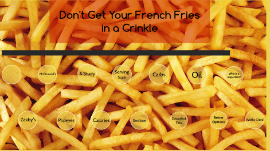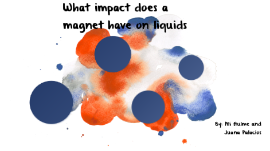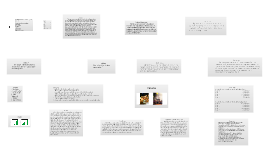Laney's Science fair powerpoint
Transcript: Don't Get Your French Fries in a Crinkle By: Laney Forsythe January 17, 2018 Is the nutritional information from fast food restaurants accurate? Zaxby's Nutrional values Zaxby's Serving Size: 142 g Calories: 370 Calories from fat: 147 Total fat: 16 g Saturated fat: 2 g Sodium: 270 mg Total Carbohydrates: 50 g Regular Crinkle Fry Regular Crinkle Fry Serving size: 227 g Calories: 590 Calories from fat: 320 Total fat: 36 g Saturated fat: 4.5 g Sodium: 430 mg Total Carbohydrates: 86 g Large Crinkle Fry Large Crinkle Fry McDonald's Nutritional Values McDonald's Small Serving Size: 75 g Calories: 230 Calories form fat: 100 Total fat: 11 g Saturated fat: 1.5 g Sodium: 130 mg Total Carbohydrates: 30 g Small Fry Medium Serving Size: 111 g Calories: 340 Calories form fat: 140 Total fat: 16 g Saturated fat: 2.5 g Sodium: 190 mg Total Carbohydrates: 44 g Medium Fry Large Serving Size: 168 g Calories: 510 Calories form fat: 220 Total fat: 24 g Saturated fat: 3.5 g Sodium: 290 mg Total Carbohydrates: 67 g Large Fry Popeyes Nutritional Values Popeyes Serving Size: 85 g Calories: 268 Calories form fat: 125 Total fat: 14 g Saturated fat: 5 g Sodium: 587 mg Total Carbohydrates: 33 g Regular Cajun Fries Regular Cajun Fries Serving Size: 225 g Calories: 804 Calories form fat: 374 Total fat: 42 g Saturated fat: 15 g Sodium: 1761 mg Total Carbohydrates: 97 g Large Cajun Fries Large Cajun Fries Do you actually know how much you're eating? A study at one college tested people given more food than the serving size and seeing if they could tell a difference. A Study The Plan The Plan The workers would serve the same people the same thing for ten days over the coarse of five months. On five days, they would receive the normal amount. On the other five days, they would give them one and a half times the normal amount. When finished the workers would get them to fill out a questionaire. When they left, they weighed the food left on their plate. The Results The Results People who ate the larger dish, ate about 43% more calories than the normal serving size. Therefore, if you have more then you will tend to eat more. Are calories bad for you? Calories are needed for energy, but too many may cause you to gain weight. In order to lose weight, your body needs to consume less calories than your body burns. Calories How is a serving size determined? A serving size is determined by the average amount people over four years old eat at one time. The serving size make it easier to compare foods that are alike. Serving Size As more sodium evolves, the body holds onto water to reduce the amount of sodium. This creates more fluid circling the cells and more blood in the veins. More blood means more chores the heart has to do and more demands on blood vessels. The extra jobs and demands can make blood vessels become rigid, leading to high blood pressure, heart attack, and stroke. How does sodium affect the body? Sodium The Effects of High Blood Pressure: High blood pressure is a main source of cardiovascular disease. It is responsible for about 66% of all strokes and 50% of heart disease. The Effects of High Blood Pressure: Carbohydrates are important in an everyday life. They help the body preserve energy. They give fuel for the nervous system and energy for muscle work. They are valuable for brain activity. They are an effect on attitude and recollection. What are carbohydrates? Carbs Foods with high saturated fat along with healthier choices (fruits and vegetables) can actually reduce blood cholesterol levels. Although if you eat too many saturated fats, it may increase your choleterol and might put your heart in danger. The American Heart Association recommends no more the 5% to 6% of saturated fats per day. If you are on a 2,000 calorie diet, that means no more than 120 calories of saturated fat per day. Are saturated fats bad for the body? Saturated Fats Most fries are soaked in corn-based oil, which is considered the poorest oil for humans. A study group claims that corn is associated to obesity and is a key ingredient in almost all fast-food sold in America. How bad is the oil used to cook in a fast food restaurant? Oil Oil contains 120 calories for each tablespoon. Instead of soaking french fries in oil and getting an extra 300 calories, try baking your fries. You could even try air-frying them. An air fryer is an appliance that cooks by moving hot air around food at a high pace and produces crunchy food. Baked vs Fried vs Air-Fried Better Options My project is important because diabetics need to know the correct amount of sugar they are taking in. Also, people who are trying to watch their weight should acknowledge that sometimes fast food restaurants give you more than the serving size. This makes the calories, sugars, fat, etc. more than what the nutritional value states. Why is it important? Why is it important? M. (2014, July 23). McDonald's USA Nutrition Facts for Popular Menu Items. Retrieved January 14, 2018, from

















